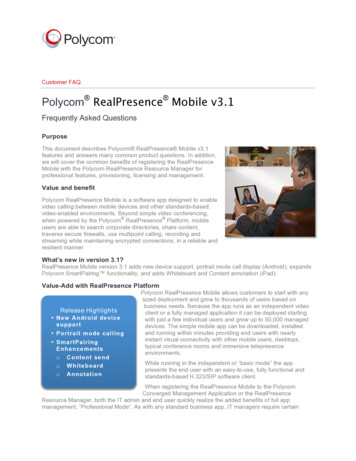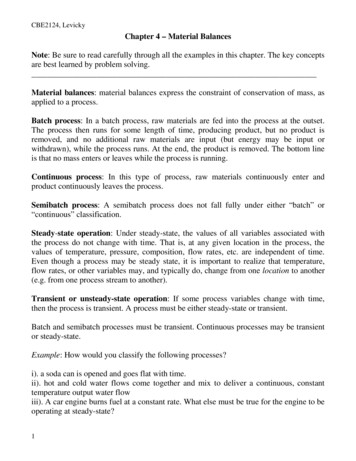
Transcription
Test-Driven DevelopmentDavid JanzenCopyright 2013 David S. Janzen
Outline§ What is TDD? An example Definitions§ § § § What is not TDD?Where did TDD come from?Why should I use TDD?How can I apply TDD effectively?Copyright 2013 David S. Janzen
What is Test-Driven Development?§ TDD is a design (and testing) approachinvolving short, rapid iterations ofUnit tests are automatedUnit TestCodeRefactorForces programmer to consider use of a methodbefore implementation of the methodCopyright 2013 David S. Janzen
TDD Example: Requirements§ Ensure that passwords meet the followingcriteria: Between 6 and 10 characters long Contain at least one digit Contain at least one upper case letterCopyright 2013 David S. Janzen
TDD Example: Write a testimport static org.junit.Assert.*;import org.junit.Test;public class TestPasswordValidator {Needed for JUnit@Testpublic void testValidLength() {PasswordValidator pv new PasswordValidator();assertEquals(true, pv.isValid("Abc123"));}This is the teeth of the test}Cannot even run test yet because PasswordValidator doesn’t exist!Copyright 2013 David S. Janzen
TDD Example: Write a testimport static org.junit.Assert.*;import org.junit.Test;public class TestPasswordValidator {@Testpublic void testValidLength() {PasswordValidator pv new PasswordValidator();assertEquals(true, pv.isValid("Abc123"));}}Design decisions:class name, constructor,method name, parameters and return typeCopyright 2013 David S. Janzen
TDD Example: Write the codepublic class PasswordValidator {public boolean isValid(String password) {if (password.length() 6 && password.length() 10) {return true;}else {return false;}}}Copyright 2013 David S. Janzen
TDD Example: Refactorimport static org.junit.Assert.*;import org.junit.Test;public class TestPasswordValidator {@Testpublic void testValidLength() {PasswordValidator pv new PasswordValidator();assertEquals(true, pv.isValid("Abc123"));}}Do we really need an instance of PasswordValidator?Copyright 2013 David S. Janzen
TDD Example: Refactor the testimport static org.junit.Assert.*;import org.junit.Test;public class TestPasswordValidator {@Testpublic void testValidLength() {assertEquals(true, PasswordValidator.isValid("Abc123"));}}Design decision:static methodCopyright 2013 David S. Janzen
What is Refactoring?§ Changing the structure of the code withoutchanging its behavior Example refactorings: RenameExtract method/extract interfaceInlinePull up/Push down§ Some IDE’s (e.g. Eclipse) includeautomated refactoringsCopyright 2013 David S. Janzen
TDD Example: Refactor the codepublic class PasswordValidator {public static boolean isValid(String password) {if (password.length() 6 && password.length() 10) {return true;}else {return false;}}}Design decision:static methodCopyright 2013 David S. Janzen
TDD Example: Refactor the codepublic class PasswordValidator {public static boolean isValid(String password) {if (password.length() 6 && password.length() 10) {return true;}else {return false;}}}Can we simplify this?Copyright 2013 David S. Janzen
TDD Example: Refactoring #1public class PasswordValidator {public static boolean isValid(String password) {return password.length() 6 &&password.length() 10;}}Refactoring #1:collapse conditionalCopyright 2013 David S. Janzen
TDD Example: Refactoring #1public class PasswordValidator {public static boolean isValid(String password) {return password.length() 6 &&password.length() 10;}}“Magic numbers” (i.e. literal constantsthat are buried in code) can be dangerousCopyright 2013 David S. Janzen
TDD Example: Refactoring #2public class PasswordValidator {private final static int MIN PW LENGTH 6;private final static int MAX PW LENGTH 10;public static boolean isValid(String password) {return password.length() MIN PW LENGTH &&password.length() MAX PW LENGTH;}}Refactoring #2:extract constantCopyright 2013 David S. Janzen
TDD Example: Write another testimport static org.junit.Assert.*;import org.junit.Test;No design decisions;just unit testingpublic class TestPasswordValidator {@Testpublic void testValidLength() {assertEquals(true, PasswordValidator.isValid("Abc123"));}@Testpublic void testTooShort() {assertEquals(false, PasswordValidator.isValid("Abc12"));}}Copyright 2013 David S. Janzen
TDD Example: Write another testpublic class TestPasswordValidator { Write a test before@Testimplementing next featurepublic void testValidLength() {assertEquals(true, PasswordValidator.isValid("Abc123"));}@Testpublic void testTooShort() {assertEquals(false, PasswordValidator.isValid("Abc12"));}@Testpublic void testNoDigit() {assertEquals(false, PasswordValidator.isValid("Abcdef"));}}Copyright 2013 David S. Janzen
TDD Example: Make the test passpublic class PasswordValidator {private final static int MIN PW LENGTH 6;private final static int MAX PW LENGTH 10;public static boolean isValid(String password) {return password.length() MIN PW LENGTH &&password.length() MAX PW LENGTH;}}Copyright 2013 David S. Janzen
TDD Example: Make the test passimport java.util.regex.Pattern;Check for a digitpublic class PasswordValidator {private final static int MIN PW LENGTH 6;private final static int MAX PW LENGTH 10;public static boolean isValid(String password) {return password.length() MIN PW LENGTH &&password.length() MAX PW LENGTH &&Pattern.matches(".*\\p{Digit}.*", password);}}Copyright 2013 David S. Janzen
TDD Example: Refactorimport java.util.regex.Pattern;Extract methodsfor readabilitypublic class PasswordValidator {private final static int MIN PW LENGTH 6;private final static int MAX PW LENGTH 10;public static boolean isValid(String password) {return password.length() MIN PW LENGTH &&password.length() MAX PW LENGTH &&Pattern.matches(".*\\p{Digit}.*", password);}}Copyright 2013 David S. Janzen
TDD Example: Done for nowimport java.util.regex.Pattern;public class PasswordValidator {private final static int MIN PW LENGTH 6;private final static int MAX PW LENGTH 10;private static boolean isValidLength(String password) {return password.length() MIN PW LENGTH &&password.length() MAX PW LENGTH;}private static boolean containsDigit(String password) {return Pattern.matches(".*\\p{Digit}.*", password);}public static boolean isValid(String password) {return isValidLength(password) &&containsDigit(password);}}Copyright 2013 David S. Janzen
TDD in Android§ Android SDK integrates JUnit 3 not JUnit 4§ Many helper TestCase classes§ Recommended best practice to put tests inseparate project but share folder Eclipse “New Android Project” wizard will do thisfor youCopyright 2013 David S. Janzen
Beware if both src and test projects use same libraries(see g-android-with-multiple.html)Copyright 2013 David S. Janzen
Copyright 2013 David S. Janzen
Android TestCase ClassesCopyright 2013 David S. Janzen
Android TestCase Classes§ Basic JUnit tests TestCase (run tests with assert methods)§ When you need an Activity Context AndroidTestCase (see getContext())§ When you want to use a Mock Context ApplicationTestCase (call setContext() beforecalling createApplication() which calls onCreate())Copyright 2013 David S. Janzen
Android TestCase Classes§ When you want to test just one Activity ActivityUnitTestCase (allows you to ask if theActivity has started another Activity or calledfinish() or requested a particular orientation)§ When you want to do a functional test on anActivity ActivityInstrumentationTestCase2 (allows you tosend key events to your Activity)Copyright 2013 David S. Janzen
Android TestCase Classes§ When you want to test a Content Provider ProviderTestCase2§ When you want to test a Service ServiceTestCase§ When you want to stress test the UI Monkey .htmlCopyright 2013 David S. Janzen
Android TestCase How-to§ Add instrumentation to AndroidManifest.xml ?xml version "1.0" encoding "utf-8"? manifest xmlns:android e “com.simexusa.testcaseexamples" android:versionCode "1"android:versionName "1.0" application android:icon "@drawable/icon" android:label "@string/app name"android:debuggable "true" uses-library android:name "android.test.runner" / activity android:name “SomeActivity android:label "@string/app name" intent-filter action android:name "android.intent.action.MAIN" / category android:name "android.intent.category.LAUNCHER" / /intent-filter /activity /application uses-sdk android:minSdkVersion "3" / instrumentation android:name rgetPackage “com.simexusa.testcaseexamples"android:label "Tests for my example."/ /manifest Copyright 2013 David S. Janzen
Android TestCase How-to§ Add instrumentation to AndroidManifest.xml When creating a second project ?xml version "1.0" encoding "utf-8"? manifest xmlns:android e nCode "1"android:versionName "1.0" application android:icon "@drawable/icon" android:label "@string/app name" uses-library android:name "android.test.runner" / /application uses-sdk android:minSdkVersion "4" / instrumentation android:targetPackage "com.simexusa.testcaseexamples"android:name "android.test.InstrumentationTestRunner" / /manifest Copyright 2013 David S. Janzen
§ Create a new JUnit Test CaseCopyright 2013 David S. Janzen
§ Create a new JUnit Test CaseCopyright 2013 David S. Janzen
Testing POJO’s§ Plain Old Java Objects (i.e. independent of frameworks like Android or J2EE)import junit.framework.TestCase;import edu.calpoly.android.lab4.Joke;public class JokeTest extends TestCase {public void testJoke() {Joke joke new Joke();assertTrue("m strJoke should be initialized to \"\".", joke.getJoke().equals(""));assertTrue("m strAuthorName should be initialized to m nRating should be initialized to Joke.UNRATED.",Joke.UNRATED, joke.getRating());}}Copyright 2013 David S. Janzen
§ Run the testsCopyright 2013 David S. Janzen
Copyright 2013 David S. Janzen
JUnit 3 How-to§ Import the JUnit frameworkimport junit.framework.*;§ Create a subclass of TestCasepublic class TestBank extends TestCase {§ Write methods in the form testXXX()§ Use assertXXX() methodspublic void testCreateBank() {Bank b new Bank();assertNotNull(b);}§ Compile test and functional code; Run aTestRunner to execute tests; Keep the bar green!Copyright 2013 David S. Janzen
Fixtures§ Notice redundancy in test methodsimport junit.framework.TestCase;public class TestBank extends TestCase {public void testCreateBank() {Bank b new Bank();assertNotNull(b);}public void testCreateBankEmpty() {Bank b new Bank();assertEquals(b.getNumAccounts(),0);}}§ Common test setup can be placed in a methodnamed setUp() which is run before each testCopyright 2013 David S. Janzen
setUp()import junit.framework.*;public class TestBank extends TestCase {private Bank b;public void setUp() {setUp() isb new Bank();}public void testCreateBank() {assertNotNull(b);}public void testCreateBankEmpty() {assertEquals(b.getNumAccounts(),0);}public void testAddAccount() {Account a new Account("John tNumAccounts(),1);}}Copyright 2013 David S. Janzenrun before each test
tearDown()§ tearDown() is run after each test Used for cleaning up resources such as files,network, or database connectionsimport junit.framework.TestCase;public class TestBank extends TestCase {private Bank b;public void setUp() {b new Bank();}public void tearDown() {tearDown() isb null;} }Copyright 2013 David S. Janzenrun after each test
Grouping Tests with @xTest§ Some tests run fast, others don’t You can separate them with @SmallTest,@MediumTest, @LargeTestpublic class JokeTest extends TestCase {@SmallTest/*** Test Default Constructor*/public void testJoke() {Joke joke new Joke();assertTrue("m strJoke should be initialized to \"\".", joke.getJoke().equals(""));assertTrue("m strAuthorName should be initialized to m nRating should be initialized to Joke.UNRATED.",Joke.UNRATED, joke.getRating());}Copyright 2013 David S. Janzen
Running Tests with @xTest§ Run the tests with adb from the command line t/InstrumentationTestRunner.htmlC:\adb shell am instrument -w -e size small ts.dflt.JokeTest:.Test results for InstrumentationTestRunner .Time: 1.975OK (13 tests)Copyright 2013 David S. Janzen
Testing Campus Mapspackage com.simexusa.campusmaps full;import com.simexusa.campusmaps full.CampusMap;import com.simexusa.campusmaps full.TranslatorUtility;import junit.framework.TestCase;public class TestTranslatorUtility extends TestCase {protected void setUp() throws Exception {super.setUp();}public void testTranslateLatToY() {double b1lat 35.302518;double b2lat 35.299365;int b1py 445;int b2py 840;double latitude ight 2013 David S. Janzen
Testing Campus Mapspackage com.simexusa.campusmaps full;import com.simexusa.campusmaps full.CampusMap;import com.simexusa.campusmaps full.TranslatorUtility;import junit.framework.TestCase;public class TestTranslatorUtility extends TestCase {protected void setUp() throws Exception {super.setUp();}public void testTranslateLatToY() {double b1lat 35.302518;double b2lat 35.299365;Test complicated methodsint b1py 445;int b2py 840;doubl
public class TestPasswordValidator { @Test public void testValidLength() { PasswordValidator pv new PasswordValidator(); assertEquals(true, pv.isValid("Abc123")); } } Needed for JUnit This is the teeth of the test Cannot even run test yet because PasswordValidator











